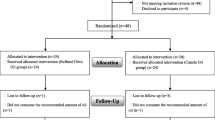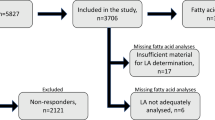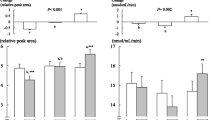Abstract
Background
Lipoprotein-associated phospholipase A2 (Lp-PLA2) is an emerging independent risk factor for cardiovascular disease (CVD). Lp-PLA2 can be modified by lipid lowering drugs, but it is unknown whether diet can reduce plasma levels of Lp-PLA2.
Aim of the study
The aim of the trial was to study the effect of marine n-3 polyunsaturated fatty acids (PUFA) on plasma Lp-PLA2 levels in healthy subjects.
Methods
Sixty healthy subjects were randomized to a moderate dose (2 g) of n-3 PUFA, a high dose (6.6 g) of n-3 PUFA or olive oil (control) daily for 12 weeks. Plasma Lp-PLA2 was measured at baseline and after the interventions.
Results
Plasma Lp-PLA2 levels were unchanged in all three groups before and after the supplements. Neither did the results differ between groups. There was no correlation between the content of n-3 PUFA in platelets or granulocytes or plasma Lp-PLA2.
Conclusion
Marine n-3 PUFA had no effect on plasma levels of Lp-PLA2 in healthy adults and relatively young people.
Similar content being viewed by others
References
Anderson JL (2008) Lipoprotein-associated phospholipase A2: an independent predictor of coronary artery disease events in primary and secondary prevention. Am J Cardiol 101:23F–33F
Ballantyne CM, Hoogeveen RC, Bang H, Coresh J, Folsom AR, Heiss G, Sharrett AR (2004) Lipoprotein-associated phospholipase A2, high-sensitivity C-reactive protein, and risk for incident coronary heart disease in middle-aged men and women in the atherosclerosis risk in communities (ARIC) study. Circulation 109:837–842
Blake GJ, Dada N, Fox JC, Manson JE, Ridker PM (2001) A prospective evaluation of lipoprotein-associated phospholipase A(2) levels and the risk of future cardiovascular events in women. J Am Coll Cardiol 38:1302–1306
Boyd HF, Fell SC, Hickey DM, Ife RJ, Leach CA, Macphee CH, Milliner KJ, Pinto IL, Rawlings DA, Smith SA, Stansfield IG, Stanway SJ, Theobald CJ, Whittaker CM (2002) Potent, orally active inhibitors of lipoprotein-associated phospholipase A(2): 1-(biphenylmethylamidoalkyl)-pyrimidones. Bioorg Med Chem Lett 12:51–55
Brilakis ES, McConnell JP, Lennon RJ, Elesber AA, Meyer JG, Berger PB (2005) Association of lipoprotein-associated phospholipase A2 levels with coronary artery disease risk factors, angiographic coronary artery disease, and major adverse events at follow-up. Eur Heart J 26:137–144
Calder PC (2006) Polyunsaturated fatty acids and inflammation. Prostaglandins Leukot Essent Fatty Acids 75:197–202
Caslake MJ, Packard CJ (2003) Lipoprotein-associated phospholipase A2 (platelet-activating factor acetylhydrolase) and cardiovascular disease. Curr Opin Lipidol 14:347–352
Christensen JH, Christensen MS, Dyerberg J, Schmidt EB (1999) Heart rate variability and fatty acid content of blood cell membranes: a dose-response study with n-3 fatty acids. Am J Clin Nutr 70:331–337
Filippatos TD, Gazi IF, Liberopoulos EN, Athyros VG, Elisaf MS, Tselepis AD, Kiortsis DN (2007) The effect of orlistat and fenofibrate, alone or in combination, on small dense LDL and lipoprotein-associated phospholipase A(2) in obese patients with metabolic syndrome. Atherosclerosis 193:428–437
Garza CA, Montori VM, McConnell JP, Somers VK, Kullo IJ, Lopez-Jimenez F (2007) Association between lipoprotein-associated phospholipase A2 and cardiovascular disease: a systematic review. Mayo Clin Proc 82:159–165
Gerber Y, McConnell JP, Jaffe AS, Weston SA, Killian JM, Roger VL (2006) Lipoprotein-associated phospholipase A2 and prognosis after myocardial infarction in the community. Arterioscler Thromb Vasc Biol 26:2517–2522
He K, Daviglus ML (2005) A few more thoughts about fish and fish oil. J Am Diet Assoc 105:350–351
He K, Song Y, Daviglus ML, Liu K, van Horn L, Dyer AR, Goldbourt U, Greenland P (2004) Fish consumption and incidence of stroke: a meta-analysis of cohort studies. Stroke 35:1538–1542
He K, Song Y, Daviglus ML, Liu K, van Horn L, Dyer AR, Greenland P (2004) Accumulated evidence on fish consumption and coronary heart disease mortality: a meta-analysis of cohort studies. Circulation 109:2705–2711
Hoogeveen RC, Ballantyne CM (2005) PLAC test for identification of individuals at increased risk for coronary heart disease. Expert Rev Mol Diagn 5:9–14
Koenig W, Khuseyinova N, Lowel H, Trischler G, Meisinger C (2004) Lipoprotein-associated phospholipase A2 adds to risk prediction of incident coronary events by C-reactive protein in apparently healthy middle-aged men from the general population: results from the 14-year follow-up of a large cohort from southern Germany. Circulation 110:1903–1908
Kolodgie FD, Burke AP, Skorija KS, Ladich E, Kutys R, Makuria AT, Virmani R (2006) Lipoprotein-associated phospholipase A2 protein expression in the natural progression of human coronary atherosclerosis. Arterioscler Thromb Vasc Biol 26:2523–2529
Kris-Etherton PM, Harris WS, Appel LJ (2002) Fish consumption, fish oil, omega-3 fatty acids, and cardiovascular disease. Circulation 106:2747–2757
Macphee CH, Nelson JJ (2005) An evolving story of lipoprotein-associated phospholipase A2 in atherosclerosis and cardiovascular risk prediction. Eur Heart J 26:107–109
Madsen T, Christensen JH, Blom M, Schmidt EB (2003) The effect of dietary n-3 fatty acids on serum concentrations of C-reactive protein: a dose-response study. Br J Nutr 89:517–522
Oei HH, van de Meer IM, Hofman A, Koudstaal PJ, Stijnen T, Breteler MM, Witteman JC (2005) Lipoprotein-associated phospholipase A2 activity is associated with risk of coronary heart disease and ischemic stroke: the Rotterdam study. Circulation 111:570–575
Oldgren J, James SK, Siegbahn A, Wallentin L (2007) Lipoprotein-associated phospholipase A2 does not predict mortality or new ischaemic events in acute coronary syndrome patients. Eur Heart J 28:699–704
Packard CJ, O’Reilly DS, Caslake MJ, McMahon AD, Ford I, Cooney J, Macphee CH, Suckling KE, Krishna M, Wilkinson FE, Rumley A, Lowe GD (2000) Lipoprotein-associated phospholipase A2 as an independent predictor of coronary heart disease: West of Scotland Coronary Prevention Study Group. N Engl J Med 343:1148–1155
Persson M, Hedblad B, Nelson JJ, Berglund G (2007) Elevated Lp-PLA2 levels add prognostic information to the metabolic syndrome on incidence of cardiovascular events among middle-aged nondiabetic subjects. Arterioscler Thromb Vasc Biol 27:1411–1416
Persson M, Nilsson JA, Nelson JJ, Hedblad B, Berglund G (2007) The epidemiology of Lp-PLA(2): distribution and correlation with cardiovascular risk factors in a population-based cohort. Atherosclerosis 190:388–396
Schmidt EB, Arnesen H, Christensen JH, Rasmussen LH, Kristensen SD, de Caterina R (2005) Marine n-3 polyunsaturated fatty acids and coronary heart disease: Part II: clinical trials and recommendations. Thromb Res 115:257–262
Schmidt EB, Arnesen H, de Caterina R, Rasmussen LH, Kristensen SD (2005) Marine n-3 polyunsaturated fatty acids and coronary heart disease: part I: background, epidemiology, animal data, effects on risk factors and safety. Thromb Res 115:163–170
Schmidt EB, Koenig W, Khuseyinova N, Christensen JH (2008) Lipoprotein-associated phospholipase A2 concentrations in plasma are associated with the extent of coronary artery disease and correlate to adipose tissue levels of marine n-3 fatty acids. Atherosclerosis 196:420–424
Schmidt EB, Pedersen JO, Varming K, Ernst E, Jersild C, Grunnet N, Dyerberg J (1991) n-3 fatty acids and leukocyte chemotaxis: effects in hyperlipidemia and dose-response studies in healthy men. Arterioscler Thromb 11:429–435
Serruys PW, Garcia-Garcia HM, Buszman P, Erne P, Verheye S, Aschermann M, Duckers H, Bleie O, Dudek D, Botker HE, von BC, D’Amico D, Hutchinson T, Zambanini A, Mastik F, van Es GA, van der Steen AF, Vince DG, Ganz P, Hamm CW, Wijns W, Zalewski A (2008) Effects of the direct lipoprotein-associated phospholipase A2 inhibitor darapladib on human coronary atherosclerotic plaque. Circulation 118: 1172–1182
Shi Y, Zhang P, Zhang L, Osman H, Mohler ERIII, Macphee C, Zalewski A, Postle A, Wilensky RL (2007) Role of lipoprotein-associated phospholipase A2 in leukocyte activation and inflammatory responses. Atherosclerosis 191:54–62
Thies F, Garry JM, Yaqoob P, Rerkasem K, Williams J, Shearman CP, Gallagher PJ, Calder PC, Grimble RF (2003) Association of n-3 polyunsaturated fatty acids with stability of atherosclerotic plaques: a randomised controlled trial. Lancet 361:477–485
Weintraub HS (2008) Identifying the vulnerable patient with rupture-prone plaque. Am J Cardiol 101:3F–10F
Conflict of interest
There are no conflicts of interest.
Funding No funding has been received.
Author information
Authors and Affiliations
Corresponding author
Rights and permissions
About this article
Cite this article
Weinkouff Pedersen, M., Koenig, W., Hagstrup Christensen, J. et al. The effect of marine n-3 fatty acids in different doses on plasma concentrations of Lp-PLA2 in healthy adults. Eur J Nutr 48, 1–5 (2009). https://doi.org/10.1007/s00394-008-0758-z
Received:
Accepted:
Published:
Issue Date:
DOI: https://doi.org/10.1007/s00394-008-0758-z




